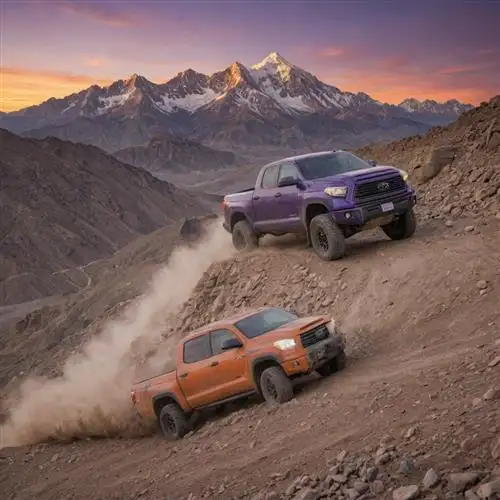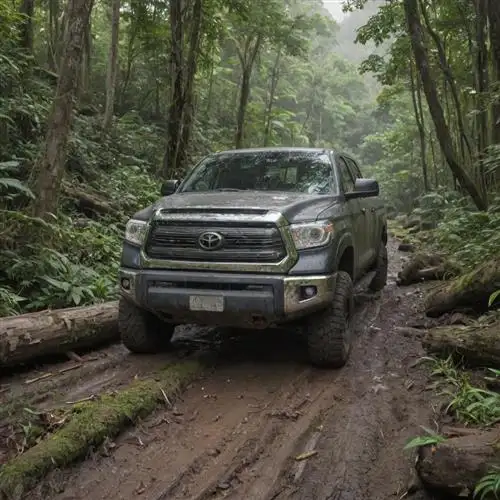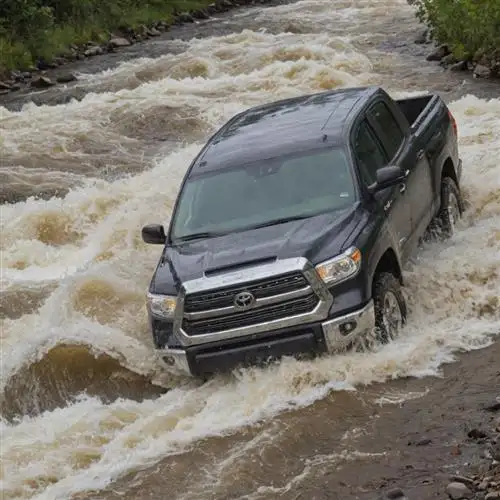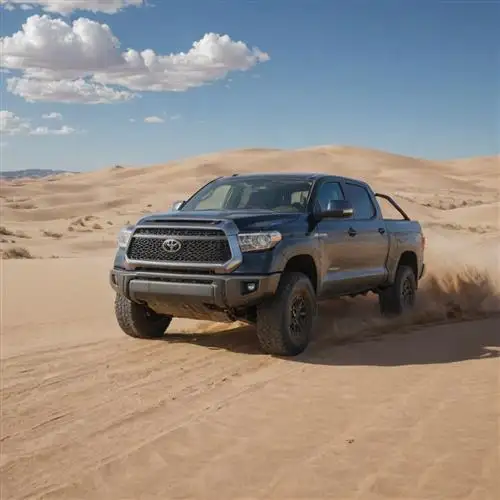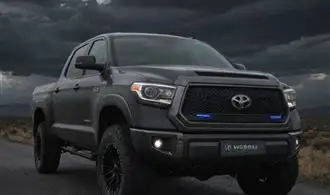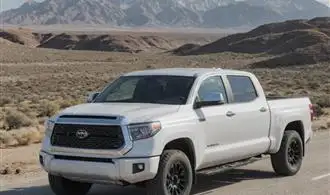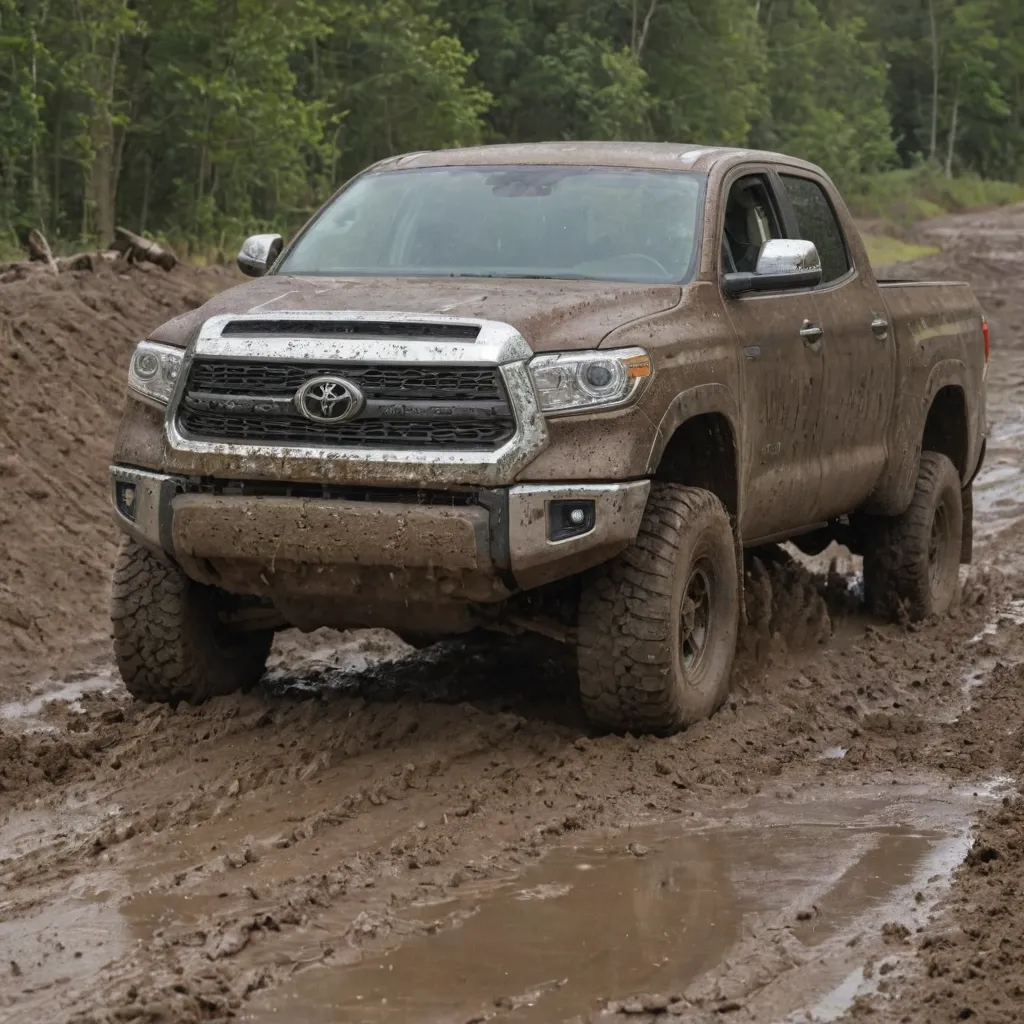
Conquer Steep Inclines
Navigating steep inclines with your Toyota Tundra is a true test of its off-road capabilities. One key factor is the Tundra's impressive ground clearance, which allows it to tackle steep climbs without scraping the undercarriage. The truck's four-wheel-drive system, featuring high and low gearing, provides the necessary traction and torque to power through even the most challenging terrain. When approaching a steep incline, it's essential to engage the four-wheel-drive system and select the appropriate gear for the task at hand.
Maintaining a slow, steady pace is crucial when climbing steep hills. Sudden acceleration or braking can cause the Tundra to lose traction and control. Gently apply the throttle, allowing the vehicle's momentum and the low-end torque to carry you up the incline. Avoid the temptation to "power through" the climb, as this can lead to wheel spin and loss of control. Instead, focus on maintaining a smooth, controlled ascent.
If the incline is particularly steep, consider engaging the Tundra's hill start assist feature. This system helps prevent the vehicle from rolling back when you take your foot off the brake on an incline, making it easier to maintain control and momentum. Additionally, the Tundra's available locking rear differential can provide increased traction when navigating challenging terrain, distributing power evenly between the rear wheels for maximum grip.
When descending a steep incline, use the truck's engine braking capabilities to control your speed. Avoid relying solely on the service brakes, as this can lead to overheating and potentially reduced braking effectiveness. Instead, shift the transmission into a lower gear and let the engine's compression help control your descent. This not only preserves the brakes but also provides a more controlled and safer descent.
Traverse Treacherous Terrain
Traversing treacherous terrain with your Toyota Tundra is an exhilarating experience that can push the limits of your vehicle's capabilities. Whether you're navigating rocky hills, muddy bogs, or steep inclines, the Tundra's robust design and powerful performance make it a formidable off-road companion. Here are some tips to help you conquer the most challenging terrain with confidence:
Engage 4-Wheel Drive: The Tundra's intuitive 4-Wheel Drive system is designed to provide maximum traction and control in demanding off-road conditions. By engaging the 4WD mode, you can effectively distribute power to all four wheels, ensuring better grip and stability on uneven surfaces.
Utilize Traction Control: The Tundra's advanced traction control system continuously monitors wheel slip and adjusts power delivery to maintain optimal grip. This feature is particularly useful when traversing loose soil, mud, or steep inclines, where wheel spin can quickly lead to loss of control.
Adjust Tire Pressure: Lowering your tire pressure can greatly improve the Tundra's off-road performance. Reducing the PSI allows the tires to conform better to the terrain, providing more surface area for traction. Just be sure to reinflate the tires before returning to paved roads.
Leverage Hill Descent Control: The Tundra's Hill Descent Control feature automatically manages the vehicle's speed and brake pressure when descending steep, treacherous slopes. This allows you to focus on steering and navigation, rather than constantly modulating the brakes.
Navigate with Confidence: Equip your Tundra with high-quality off-road navigation tools, such as a rugged GPS system or a mapping app that can provide detailed information about the terrain ahead. This will help you identify and plan for any challenging obstacles or features along your route.
Protect Your Undercarriage: Consider adding a set of skid plates or undercarriage protection to your Tundra. These components can help shield vital components, such as the fuel tank, transfer case, and differential, from damage when traversing rocky or uneven terrain.
Tackle Deep Water Crossings
Venturing off the beaten path in your Toyota Tundra can be an exhilarating experience, and one of the most thrilling challenges is navigating through deep water crossings. These submerged obstacles can test the limits of your truck's capabilities, but with the right preparation and technique, you can conquer them with confidence.
Firstly, it's crucial to assess the depth of the water crossing. Use a sturdy stick or pole to gauge the depth, ensuring it's no more than the maximum recommended wading depth for your Tundra model. Proceed cautiously, keeping a steady pace and avoiding sudden stops or accelerations, which can cause water to enter the engine compartment.
Proper vehicle preparation is key. Ensure your air intake is positioned high enough to prevent water ingestion, and consider installing a snorkel kit to further elevate the air intake. This not only protects your engine but also allows you to tackle deeper water with greater ease.
When approaching the crossing, maintain a steady, moderate speed, typically around 5-10 mph. This helps create a bow wave that pushes water away from the vehicle, reducing the risk of water entering the engine bay. Avoid revving the engine, as this can cause water to be drawn into the intake.
Carefully monitor your surroundings, looking for any sudden drops or obstacles that could compromise the crossing. If the water is murky or the bottom is not visible, proceed with caution and be prepared to stop or turn back if necessary.
After successfully navigating the water crossing, it's essential to check your vehicle for any signs of water intrusion. Inspect the differential, transfer case, and other critical components to ensure they are functioning properly. If necessary, perform a fluid change to remove any contaminants that may have entered the system.
Dominate Dunes and Deserts
Traversing the vast, undulating dunes and barren landscapes of the desert with your Toyota Tundra is an exhilarating experience that tests the limits of both driver and machine. The Tundra's robust construction, impressive ground clearance, and powerful four-wheel-drive system make it a formidable off-road companion, capable of conquering even the most challenging terrain. From navigating steep inclines to tackling deep sand, the Tundra's capabilities can be fully maximized with the right techniques and modifications.
One of the keys to dominating the dunes and deserts is to ensure your Tundra is properly equipped. Upgrading the suspension with lift kits or heavy-duty shocks can provide the necessary clearance and articulation to overcome obstacles. Investing in oversized, all-terrain tires can also significantly improve traction and flotation in soft, sandy conditions. Additionally, consider adding skid plates and underbody protection to safeguard your vehicle from the hazards of off-road driving.
When tackling dunes, the art of momentum and controlled slides becomes crucial. Maintaining a steady, moderate speed and anticipating the terrain ahead can help you surf the slopes with grace. Feathering the throttle and using the Tundra's impressive torque to your advantage can allow you to climb and descend the dunes with confidence. Remember to engage the four-wheel-drive system and, if necessary, lower the tire pressure to improve flotation and reduce the risk of becoming stuck.
In the vast, open expanses of the desert, the Tundra's robust powertrain and off-road-tuned suspension come into their own. Navigating winding trails, rocky sections, and dry riverbeds requires a keen eye, smooth inputs, and the ability to read the terrain. Don't Customize Your Toyota Tundra Until You Read This to ensure your modifications enhance, rather than compromise, the Tundra's off-road prowess.
Tackle Muddy Conditions
Tackling muddy conditions with your Toyota Tundra is an exhilarating and challenging experience that separates the off-road enthusiasts from the casual drivers. When navigating through thick, sloppy mud, it's essential to understand the nuances of your vehicle's capabilities and employ the right techniques to ensure a safe and successful journey. One of the key factors in conquering mud is maintaining momentum. By keeping your Tundra's wheels turning at a steady pace, you can plow through the muck without getting bogged down. It's also crucial to avoid sudden accelerations or braking, as this can cause your wheels to spin and dig you deeper into the mud.
Another important consideration is your tire choice. Investing in a set of high-quality, mud-terrain tires can make a significant difference in your Tundra's off-road performance. These tires are designed with deeper, more aggressive treads that provide better grip and traction in soft, slippery conditions. Additionally, adjusting your tire pressure can be a game-changer. Lowering the pressure slightly can increase the tire's surface area, allowing it to float more easily on the mud and reduce the chances of getting stuck.
If you find yourself in a particularly challenging mud pit, don't be afraid to utilize your Tundra's four-wheel-drive capabilities. Engaging the low-range gears and locking the differential can provide the extra torque and traction needed to power through. It's also worth considering the use of a winch or tow strap if you anticipate getting stuck, as these tools can be invaluable for self-recovery or assistance from other off-road vehicles.
One final tip for tackling muddy conditions is to be aware of your surroundings and plan your route accordingly. Carefully observe the terrain and look for areas with a firmer, more stable base to navigate through. Avoid deep, soupy patches and opt for drier, more compact sections if possible. Remember, safety should always be your top priority when venturing off-road, so be prepared, stay alert, and enjoy the thrill of conquering the mud in your Toyota Tundra.

